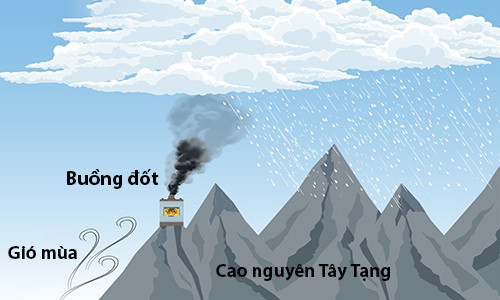The world's largest rain-generating system
China uses fuel combustion chambers to create silver iodide particles to help form clouds and rain.
China is developing the world's largest rain-generating system with an area of 1.6 million square kilometers, three times the size of Spain, South China Morning Post March 27 reported. The system, consisting of tens of thousands of fuel-burning chambers, is installed on the Tibetan plateau, which can increase rainfall in the region by up to 10 billion cubic meters per year, equivalent to 7% of total water consumption in China.
Solid fuel combustion chambers are located on steep slopes, catching wet monsoon winds from South Asia. Scientists use them to create silver iodide particles, a cloud-forming agent with a rock-like crystal structure. Humid monsoon winds will combine with silver iodide particles produced by the combustion chamber, forming a cloud to cause rain and snow.

Rain-generating system with solid fuel combustion chamber on Tibetan plateau.(Photo: SCMP).
"Currently, more than 500 combustion chambers have been deployed on top of mountains in Tibet, Xinjiang and some other areas for testing. Collected data shows very positive results , " said a researcher of shared project.
The project is currently developed by China Aerospace Science and Technology Corporation. Scientists have designed and built combustion chambers based on advanced rocket engine technology, allowing the system to efficiently burn solid fuel in an oxygen-free environment at a height of more than 5,000 meters above water level. sea. After many design improvements, the combustion chamber can operate in a vacuum near the environment for months and even years without maintenance.
The rain-generating system with solid fuel combustion chambers is not a new idea, some countries like the United States have experimented on a small scale, but China is the first country to apply technology on such a large scale.
The cost of developing an underground rain generation system is relatively cheap compared to the method of creating rain by air. The cost of manufacturing and installing each chamber is about 8,000 USD, which may be lower if mass production. Meanwhile, a rain-generating aircraft can cost hundreds of thousands of dollars and only on small scale.
Tibet is known as Asia's largest freshwater reserve area with huge glaciers and freshwater reserves in the ground. They are the main source of water for the largest rivers in the continent, such as the Yellow, Yangtze, Salween and Brahmaputra rivers.
- Rain by laser
- Japan has the first artificial rain after 12 years
- Using a laser to create rain, control the weather
- Japan developed a flood forecasting system due to rain
- Heavy rain of rain on Lake Hungary
- Video: Is it less wet to run or go in the rain?
- The truths always amaze you about the biological world
- What is acid rain? How are the effects of acid rain?
- France blocks 'gate connecting the worlds'
- Video: The secret to predict when the rain will come
- When will the clouds turn into rain?
- NASA is about to announce the world of the solar system in the solar system
 'Fine laughs' - Scary and painful torture in ancient times
'Fine laughs' - Scary and painful torture in ancient times The sequence of numbers 142857 of the Egyptian pyramids is known as the strangest number in the world - Why?
The sequence of numbers 142857 of the Egyptian pyramids is known as the strangest number in the world - Why? History of the iron
History of the iron What is alum?
What is alum?